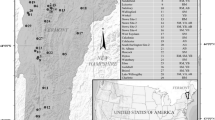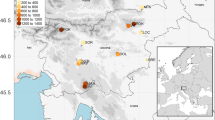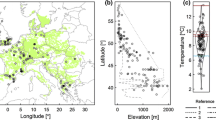Abstract
Concern exists as to the status of red spruce (Picea rubens Sarg.) in the Great Smoky Mountains, with evidence both for and against an unprecedented decline in radial growth during the past century. On the basis of a dendrological record from 1850 to 1998, our analyses support a decline in radial growth starting as early as the 1940s through to the 1970s; in the 1970s there was a reversal of this decline. In comparing trees near ridges (2000 m) with those in draws (1500 m), we found differences in the (a) timing of the decline, (b) rate of decline, and (c) homogeneity of the decline, with trees near ridges showing earlier, faster, and more homogeneous declines than trees in draws. We hypothesized that changes in climatic conditions and/or atmospheric pollutants, both of which changed beyond ranges of natural variability, were related to the observed decline in radial growth. In trees near ridges, up to 67.1% of changes in radial growth could be explained by a combination of climatic conditions (7.6%) and annual emissions of nitric oxides (NOx) and sulfur dioxide (SO2) (an additional 59.5%). In trees from draws, up to 38.3% of the changes in radial growth could be explained by climatic conditions only. A conceptual model is presented, where trees in naturally acidic soils with low base saturation provide a sensitive signal for the changing nature of acidic pollutants, but trees in anthropogenically acidifying soils with an initially higher baser saturation provide a signal that is confounded by a transient increase of calcium (Ca) and magnesium (Mg) in the soil that results in a transient increase in radial growth.
Similar content being viewed by others
References
Adams, H. S., Stephenson, J. L., Blasing, T. J. and Duvick, D. N.: 1985, ‘Growth-trend declines of spruce and fir in the mid-Appalachian subalpine forests’, Environ. Exp. Bot. 25, 315–325.
Baes, C. F. III and McLaughlin, S. B.: 1984, ‘Trace elements in tree rings: Evidence of recent and historical air pollution’, Science 224, 494–497.
Barker, M., Van Miegroet, H., Nicholas, N. S. and Creed, I. F.: 2002, ‘Variation in overstory nitrogen uptake in a small, high-elevation southern Appalachian spruce-fir watershed’, Can. J. Forest. Res. 32, 1741–1752.
Bondietti, E. A., Baes, C. F. III and McLaughlin, S. B.: 1989, ‘Radial trends in cation ratios in tree rings as indicators of the impact of atmospheric deposition on forests’, Can. J. Forest. Res. 19, 586–594.
Bondietti, E. A., Momoshima, N., Shortle, W. C. and Smith, K. T.: 1990, ‘A historical perspective on divalent cation trends in red spruce stemwood and the hypothetical relationship to acidic deposition’, Can. J. Forest. Res. 20, 1850–1858.
Cain, S. A.: 1935, ‘Ecological studies of the vegetation of the Great Smoky Mountains II: The quadrat method applied to sampling spruce and fir forest types’, Am. Midl. Nat. 16, 566–584.
Ciesla, W. M., Lambert, H. L. and Franklin, R. T.: 1963, ‘The status of the balsam wooly aphid in North Carolina and Tennessee’, Report 1–11–63, USDA Forest Service, State and Private Forestry, Forest Pest Management, Asheville, NC.
Cook, E. R.: 1988, ‘A tree ring analysis of red spruce in the southern Appalachian mountains’, in P. C. Van Deusen (eds.), Analyses of Great Smoky Mountain Red Spruce Tree Ring Data, General Technical Report SO-69, USDA Forest Service, Southern Forest Experiment Station, New Orleans, LA, U.S.A.
Cook, E. R. and Johnson, A. H.: 1989, ‘Climate change and forest decline: A review of the red spruce case’, Water Air Soil Pollut. 48, 127–140.
Cook, E. R. and Zedaker, S. M.: 1992, ‘The dendroecology of red spruce decline’, in C. Eagar and M.B. Adams (eds), Ecology and Decline of Red Spruce in the Eastern United States, Springer-Verlag, New York, NY, U.S.A., pp. 192–231.
Cook, E. R., Johnson, A. H. and Blasing, T. J.: 1987, ‘Forest decline: Modeling the effect of climate in tree rings’, Tree Physiol 3, 27–40.
EPA: March 2000: ‘National air pollutant emission trends 1900–1998’, EPA 454/R–00–002.
Fernandez, I. J.: 1992, ‘Characterization of Eastern U.S. spruce-fir soils’, in C. Eagar and M. B. Adams(eds), Ecology and Decline of Red Spruce in the Eastern United States, Springer-Verlag, New York, NY, U.S.A., pp. 40–63.
Hollingsworth, R. G. and Hain, F. P.: 1992, ‘Balsam woolly adelgid effects on wood and bark structure of Fraser fir and Silver fir’, Environ. Entomol. 21, 1103–1109.
Hornbeck, J. W. and Smith, R. B.: 1985, ‘Documentation of red spruce growth decline’, Can. J. Forest.Res. 15, 1199–1201.
Johnson, A. H. and Siccama, T. G.: 1983, ‘Acid deposition and forest decline’, Environ. Sci. Technol. 17, 294–305.
Johnson A. H. et al.: 1992, ‘Synthesis and conclusions from epidemiological and mechanistic studies of red spruce decline’, In C. Eagar and M. B. Adams (eds), Ecology and Decline of Red Spruce in the Eastern United States, Springer-Verlag, New York, NY, U.S.A., pp. 385–412.
Johnson, D. W. and Fernandez, I. J.: 1992, ‘Soil mediated effects of atmospheric deposition on eastern U.S. spruce-fir forests’, in C. Eagar and M. B. Adams (eds), Ecology and Decline of Red Spruce in the Eastern United States, Springer-Verlag, New York, NY, U.S.A., pp. 235–276.
Johnson, D. W. and Lindberg, S. E.: 1992, Atmospheric Deposition and Forest Nutrient Cycling: A Synthesis of the Integrated Forest Study, Springer-Verlag, New York, NY, U.S.A., 707 pp.
Johnson, D. W., Van Miegroet, H., Lindberg, S. E., Harrison, R. B. and Todd, D. E.: 1991, ‘Nutrient cycling in red spruce forests of the Great Smoky Mountains’, Can. J. Forest Res. 21, 769–787.
Joslin, J. D., Kelly, J. M. and Van Miegroet, H.: 1992, ‘Soil chemistry and nutrition of North American red spruce-fir stands: Evidence for recent change’, J. Environ. Qual. 21, 12–29.
LeBlanc, D. C., Nicholas, N. S. and Zedaker, S. M.: 1992, ‘Prevalence of individual-tree growth decline in red spruce populations of the southern Appalachian Mountains’, Can. J. Forest Res. 22, 905–914.
Lindberg, S. E. and Owens, J. G.: 1993, ‘Throughfall studies of deposition to forest edges and gaps in montane ecosystems’, Biogeochemistry 19, 173–194.
McLaughlin, S. B.: 1985, ‘Effects of air pollution on forests: A critical review’, J. Air Pollut. Control Assoc. 35, 516–534.
McLaughlin, S. B. and Wimmer, R.: 1999, ‘Calcium physiology and terrestrial ecosystem processes’, New Phytol. 142, 373–417.
McLaughlin, S. B., Joslin, J. D., Robarge, W., Stone, A., Wimmer, R. and Wullschleger, S. D.: 1998, ‘The impacts of acidic deposition and global change on high elevation southern Appalachian spruce-fir forests’, in R. A. Mickler and S. Fox (eds), The Productivity and Sustainability of Southern Forest Ecosystems in a Changing Environment, Springer-Verlag, NewYork, NY, U.S.A., pp. 255–277.
McLaughlin, S. B., Downing, D. J., Blasing, T. J., Cook, E. R. and Adams, H. S.: 1987, ‘An analysis of climate and competition as contributors to decline of red spruce in high elevation Appalachian forests of the Eastern United States’, Oecologia 72, 487–501.
McLaughlin, S. B., Anderson, C. P., Edwards, N. T., Roy, W. K. and Layton, P. A.: 1990, ‘Seasonal patterns of photosynthesis and respiration of red spruce saplings from two elevations in declining southern Appalachian stands’, Can. J. Forest Res. 20, 485–495.
McLaughlin, S. B., Anderson, C. P., Hanson, P. J., Tjoelker, M. G. and Roy, W. K.: 1991, ‘Increased dark respiration and calcium deficiency of red spruce in relation to acidic deposition at high-elevation southern Appalachian Mountain sites’, Can. J. Forest Res. 21, 1234–1244.
McLaughlin, S. B., Tjoelker, M. G. and Roy, W. K.: 1993, ‘Acid deposition alters red spruce physiology — laboratory studies support field observations’, Can. J. Forest Res. 23, 380–386.
Mohnen, V. A.: 1992, ‘Atmospheric deposition and pollutant exposure of eastern U.S. forests’, in C. Eagar and M. B. Adams (eds.), Ecology and Decline of Red Spruce in the Eastern United States, Springer-Verlag, New York, NY, U.S.A., pp. 64–124.
Nicholas, N. S., Zedaker, S. M. and Eagar, C.: 1992, ‘A comparison of overstory community structure in three southern Appalachian spruce-fir forests’, B. Torrey Bot. Club 119, 316–332.
Nicholas, N. S., Eagar, C. and Peine, J. D.: 1999, ‘Threatened ecosystem: High elevation spruce-fir forest’, in J. D. Peine (ed), Ecosystem management for sustainability: Principles and Practices Illustrated by a Regional Biosphere Reserve Cooperative, Lewis Publishers, Boca Raton, FL, U.S.A., pp. 431–454.
Oosting, H. J. and Billings, W. D.: 1951, ‘A comparison of virgin spruce-fir forest in the northern and southern Appalachian system’, Ecology 32, 84–103.
Ord, J. K. and Derr, J. A.: 1988, ‘Utilizing time series models and spatial analysis of forecast residuals for tree ring analysis of red spruce’, in P. C. Van Deusen (ed), Analyses of Great Smoky Mountain.Red Spruce Tree Ring Data, General Technical Report SO-69, USDA Forest Service, Southern Forest Experiment Station, New Orleans, LA, U.S.A.
Pauley, E. F. and Clebsch, E. E. C.: 1990, ‘Patterns of Abies fraseri regeneration in Great Smoky Mountains spruce-fir forest’, B. Torrey Bot. Club 117, 375–381.
Peart, D. R., Nicholas, N. S., Zedaker, S. M., Miller-Weeks, M. M. and Siccama, T. G.: 1992, ‘Conditions and recent trends in high-elevation red spruce populations’, in C. Eagar and M. B. Adams (eds), Ecology and Decline of Red Spruce in the Eastern United States, Springer-Verlag, New York, NY, U.S.A., pp. 124–191.
Reams, G. A., Nicholas, N. S. and Zedaker, S. M.: 1993, ‘Two hundred year variation of southern red spruce radial growth as estimated by spectral analysis’, Can. J. Forest Res. 23, 291–301.
Reuss, J. O. and Johnson, D. W.: 1986, Acid Deposition and the Acidification of Soil and Water, Springer-Verlag, New York, NY, U.S.A., 119 pp.
Shanks, R. E.: 1954, ‘Climates of the Great Smoky Mountains’, Ecology 35, 354–361.
Shortle, W. C. and Smith, K. T.: 1988, ‘Aluminum-induced calcium deficiency syndrome in decline red spruce’, Science 240, 1017–1018.
Shortle, W. C., Smith, K. T., Minocha, R., Lawrence, G. B. and David, M. B.: 1997, ‘Acidic deposition, cation mobilization, and biochemical indicators of stress in healthy red spruce’, J. Environ. Qual. 26, 871–876.
Smith, G. F. and Nicholas, N. S.: 1998, ‘Patterns of overstory composition in the fir and fir-spruce forests of the Great Smoky Mountains after balsam woolly adelgid infestation’, Am. Midl. Nat. 139, 340–352.
Smith, G. F. and Nicholas, N. S.: 2000, ‘Size-and age-class distributions of Fraser fir following balsam woolly adelgid infestation’, Can. J. Forest Res. 30, 948–957.
Speers, C. F.: 1958, ‘The balsam woolly aphid in the southeast’, J. Forest. 56, 515–516.
SPSS Inc.: 1997, SigmaStat, Version 2.03 for Windows 95, NT & 3.1, Chicago, IL, U.S.A.
Van Deusen, P. C.: 1988, Analyses of Great Smoky Mountain Red Spruce Tree Ring Data, General Technical Report SO-69, USDA Forest Service, Southern Forest Experiment Station, New Orleans, LA, U.S.A., 67 pp.
Van Miegroet, H., Johnson, D. W. and Todd, D. E.: 1993, ‘Foliar response of red spruce saplings to fertilization with Ca and Mg in the Great Smoky Mountains National Park’, Can J. Forest Res. 23, 89–95.
White, P. S. and Cogbill, C. V.: 1992, ‘Spruce-fir forests of Eastern America’, in C. Eagar and M. B. Adams (eds), Ecology and Decline of Red Spruce in the Eastern United States, Springer-Verlag, New York, NY, U.S.A., pp. 3–39.
Whittaker, R. H.: 1956, ‘Vegetation of the Great Smoky Mountains’, Ecol. Monogr. 26, 1–80.
Wigley, T. M. L., Briffa, K. R. and Jones, P. D.: 1984, ‘On the average value of correlated time series, with applications in dendroclimatology and hydrometerology’, J. Clim. Appl. Meteorol. 23, 201–213.
Wolfe, J. A.: 1967, ‘Forest soil characteristics as influenced by vegetation and bedrock in the spruce-fir zone of the Great Smoky Mountains’, Ph.D. Dissertation, University of Tennessee, Knoxville, TN. Diss. Abstract No. 68–9839.
Zedaker, S. M. and Nicholas, N. S.: 1990, Quality Assurance Methods Manual for Forest Site Classification and Field Measurements, 2nd edn., Environmental Research Laboratory, US Environmental Protection Agency, Corvallis, OR, U.S.A., 46 pp.
Author information
Authors and Affiliations
Rights and permissions
About this article
Cite this article
Webster, K.L., Creed, I.F., Nicholas, N.S. et al. Exploring Interactions between Pollutant Emissions and Climatic Variability in Growth of Red Spruce in the Great Smoky Mountains National Park. Water, Air, & Soil Pollution 159, 225–248 (2004). https://doi.org/10.1023/B:WATE.0000049179.26009.7f
Issue Date:
DOI: https://doi.org/10.1023/B:WATE.0000049179.26009.7f




